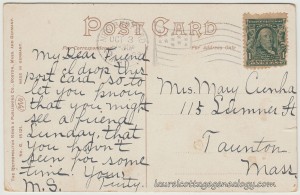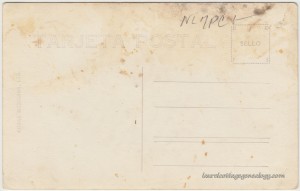“New Bedford, Mass. One of New Bedford Quaint Streets. Johney Cake Hill, Corner Union and Bethel Streets.”
This is the second of three cards in The Cunha Family Collection. The sender wrote:
“My Dear Friend, I drop this post card so to let you know that you might see a friend Sunday, that you havn’t seen for some time. Yours Truly. M.S.”
Sent to: “Mrs. Mary Cunha, 115 Sumner St., Taunton, Mass.”
Behind the name
The definition of “bethel” is a holy place or a chapel for seamen. The street name Bethel is present-day Johnny Cake Hill; the address of 15 Johnny Cake Hill being home to the Seaman’s Chapel whose facade bears a plaque with a quote from Herman Melville’s Moby Dick. (See below for an interesting 1928 newspaper article from the Emporia, Kansas’ Emporia Gazette.) A Wiki article on New Bedford tells us that the city’s nickname is “The Whaling City” because it was one of the most important whaling ports during the 19th century; also that the area that includes New Bedford, Greater Providence and Fall River is home to the largest Portuguese-American community in the U.S.
The Bethelen Cafe
Always intrigued by the small shops and restaurants that appear in these town views, we looked for the Bethelen Cafe that shows on the corner there, but didn’t find any specific mention of it in city directories, Google books, or historical newspapers currently online. Perhaps it was replaced by The New Bedford Whaling Museum? No, the well-known museum is up the street a ways. But check out the following page from Roger Chartier’s WhalingCity.net which shows a detailed history with several wonderful old photos of the corner of Union and Bethel, including one of the St. Helena restaurant. You’ll be able to take in the detail of the fountain in front of the restaurant – note that there is also a fountain in our postcard image but it’s a different one. Since our postcard was sent in 1909, an estimated time-frame for the card’s view would be that year or within several years prior. We might guess that the Bethelen was a brief successor to the St. Helena Restaurant, with the name Bethelen being a combination of Bethel and Helena.
1928 newspaper article re the Seaman’s Bethel (courtesy Newspapers.com).
Divided back, used postcard. Postmarked October 3, 1909 from New Bedford, Mass. Publisher: The Metropolitan News & Publishing Co., Boston, Mass. and Germany. No. G 15 121. Made in Germany.
Note: At the time of this posting, surprisingly, no other postcards of the same view are showing up online.
Price: $15.00
Sources: New Bedford, Massachusetts. n.d. https://en.wikipedia.org/wiki/New_Bedford,_Massachusetts. (accessed October 25, 2015).
Chartier, Roger. “St. Helena Restaurant – Cafe…” WhalingCity.net. (Web accessed October 25, 2015.)
“Moby Dick” Mast In Tars’ Pulpit Must Be Torn Down. Emporia Gazette. 19 Jan 1928. Thur, p. 6. (Newspapers.com)











